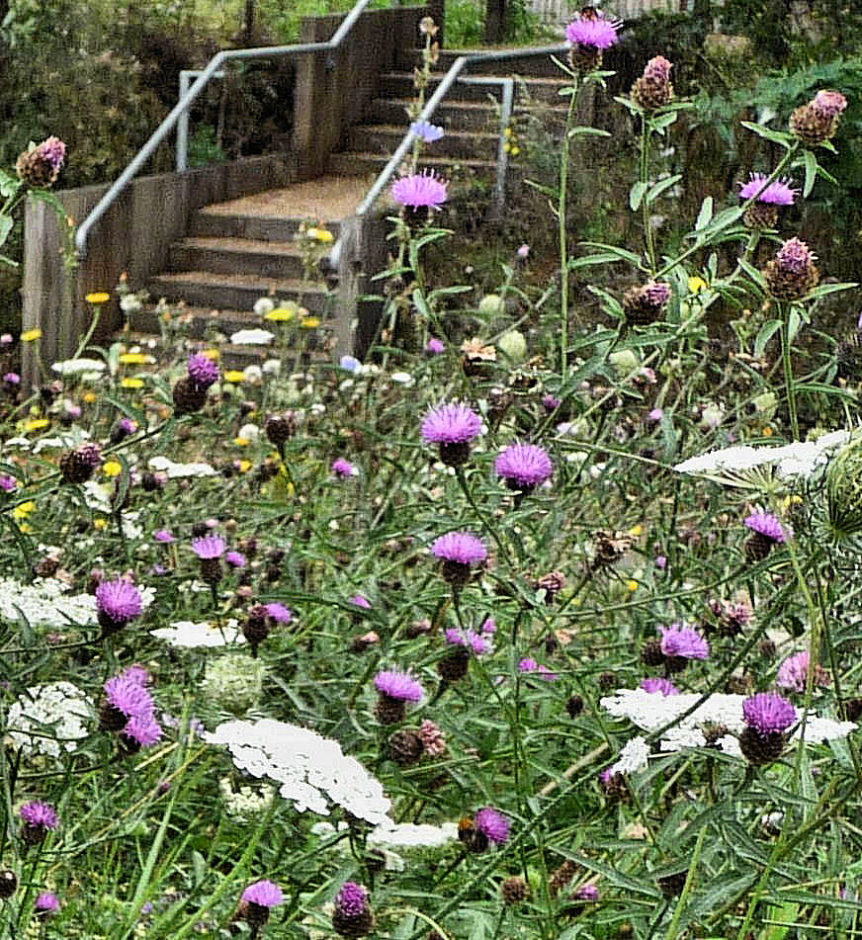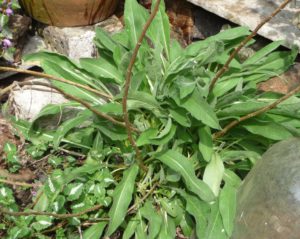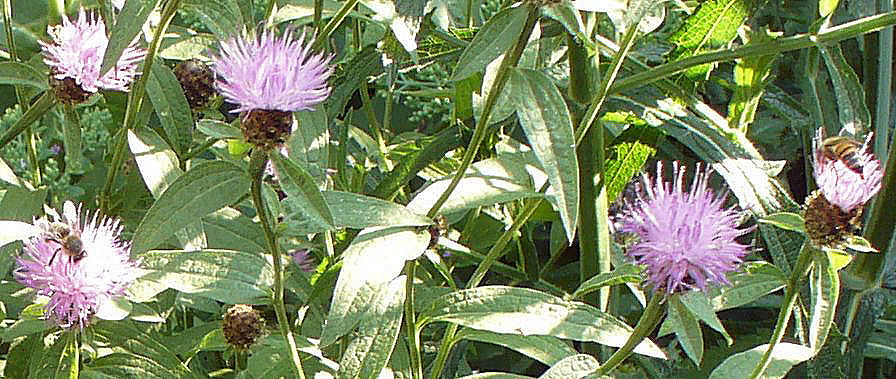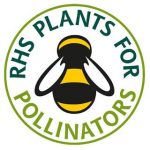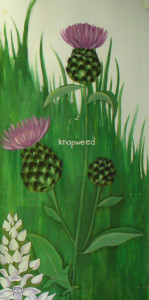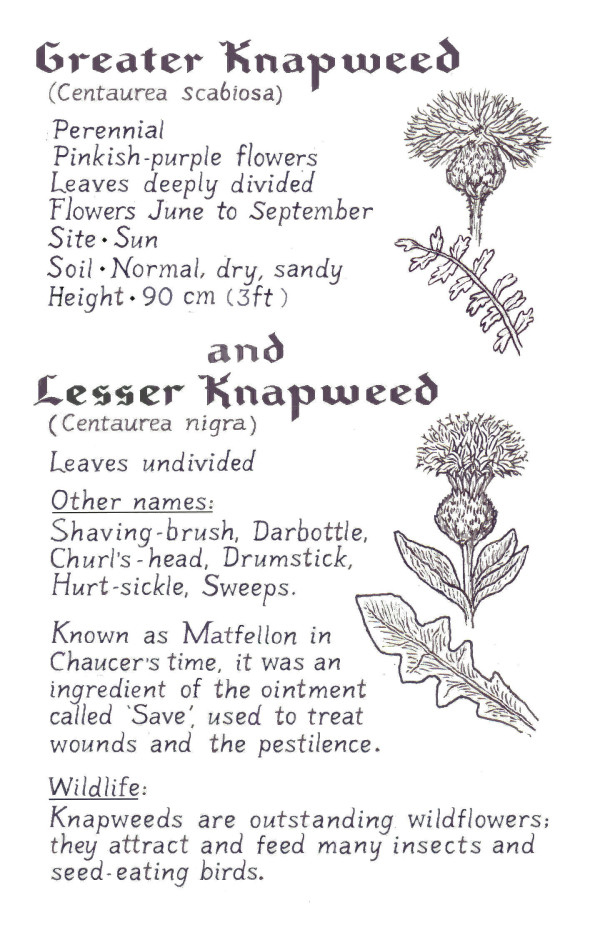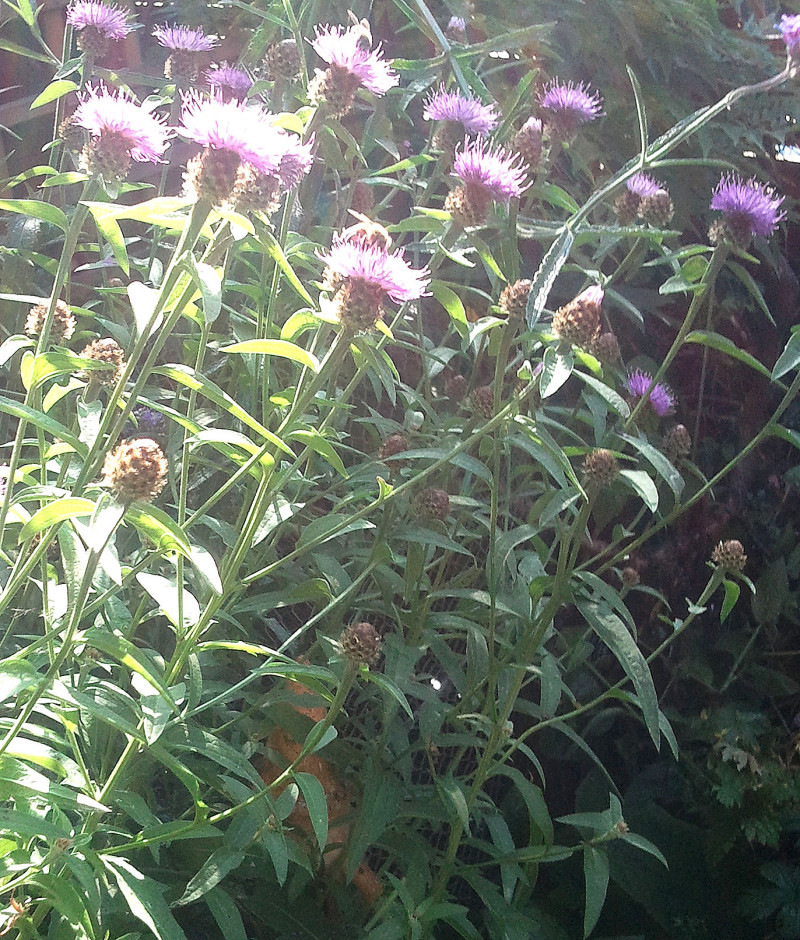LESSER KNAPWEED (Centaurea nigra)
LESSER KNAPWEED (Centaurea nigra/Hardheads)
Europe and North Africa
Lesser Knapweed is a meadow wildflower native to the Mediterranean region and western Europe, especially western France & Great Britain.
This perennial is a sun-lover; it cannot grow in shade. Found on clay soils throughout Europe, it adapts to sand, loam & alkaline soils. Centaurea nigra grows to a height of 3ft on poor ground, reaching 4ft in enriched, well-drained garden soil. It tolerates drought.
Lesser Knapweed flowers from June to September, with knobbly, thistle-like PURPLE pincushions that are pollinated by bees, flies, moths and butterflies.
Although Centaurea nigra can flower until September, it usually only blooms until late August here in North London. But for every day a flower blooms it is a magnet for insects. You can almost hear the bees sigh as they fly in to find that the last shaving brush has gone over.
Bees’ Favourite
Around the UK, bees, moths, hoverflies & butterflies – including Brimstone, Comma, Common Blue, Large Skipper, Marbled White, Meadow Brown, Painted Lady, Peacock, Red Admiral, Small Copper, Small Heath, Small Skipper & Small Tortoiseshell – visit this wildflower.
High in Nectar Production
‘It was rated in the top 5 for most nectar production (nectar per unit cover per year) in a UK plants survey conducted by the AgriLand project which is supported by the UK Insect Pollinators Initiative. It also placed second as a producer of nectar sugar per floral unit among the meadow perennials, in another study in Britain.’
In Europe, the plant is an important source of food for the European goldfinch, honey bee, lime-speck & pug moth, wikipedia
Other names: Bachelors Buttons, Black Knapweed, Blue Bottle, Brown Knapweed, Bunds, Centauree Noire, Dromedary, Drummer Boys, Drummer Heads, Gnat-flower, Hackymore, Hairy Head, Hard Hack, Hardheads, Hickymore, Horse Hardhead, Horsehoof, Horse Knot, Iron Knobs, Ironweed, Isenheard (Old English), Knot-weed, Lady’s Cushion, Spanish Buttons, Tassle, Yronhard & Zwarte Knoop.
Knapweed at Highbury
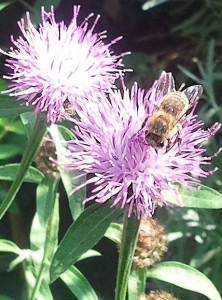 At Highbury Lessser Knapweed overwinters with a circle of green leaves at ground level & the dry brown stems of last year’s plant, which we leave in place. In spring, new stems rise from fresh leaves & masses of knobbly brown buds form at the stem-tips. By June these dusty buds open into small ‘shaving brushes’ with shaggy LAVENDER heads. They are pollinated by bees, flies, moths & butterflies.
At Highbury Lessser Knapweed overwinters with a circle of green leaves at ground level & the dry brown stems of last year’s plant, which we leave in place. In spring, new stems rise from fresh leaves & masses of knobbly brown buds form at the stem-tips. By June these dusty buds open into small ‘shaving brushes’ with shaggy LAVENDER heads. They are pollinated by bees, flies, moths & butterflies.
It is as though bees overfly the garden in spring, keeping watch on the Knapweed. When its brown buds have at last become pincushions, the pollinators come. Soon the air above the Knapweed is alive with insects seeking pollen & nectar
“It is one of the most amazing Bee plants around. with its late fall blooms bees can forage on it when nothing else is around. I have a big patch of it on our property. we were worried because we were told that it will take over and its “invasive” we left it for the bees and found out that it is a miracle plant! the poor soil 8 years ago is now rich and so much grows in it now! plus once the soil gets to nutrient rich the knapweed dies back!! so not only did it provide food for our bees, replenish the soil with its tap roots pulling nutrients up it then dies back once its completed this process….now I find out we can eat it! YAY.”
ABBAS, http://herbs-treatandtaste.blogspot.com/2011/10/knapweed-almost-forgotten-medicinal.html
Greater Knapweed (Centaurea scabiosa)
Another of the Knapweed family, Centaurea scabiosa is also a magnet for pollinators. It is found mainly in England in hedgerows, on chalky soils, dry grasslands, cliffs & lime-rich soils.
This hardy perennial grows up to 2 to 3 feet tall. From July to September, thistle-like flowerheads in PINK & PURPLE rise above the plant like suspended pincushions, drawing to them bees, butterflies, moths & every manner of pollinating insect.
Medicinal
‘The roots and seeds are diaphoretic, diuretic, tonic and vulnerary. The plant once had a very high reputation as an ingredient of the Medieval ‘salve’, an ointment applied to heal wounds and treat skin infections.’ PFAF (Plants for a Future Database), Centaurea Scabiosa Greater Knapweed, https://pfaf.org/user/Plant.aspx?LatinName=Centaurea+scabiosa
Other names: Bullweed, Hard irons, Hard head, Horse knops, Matt fellon, Matte felon & Ironhead.
Find UK grown knapweed, available from :
British Wild Flower Plants
 This Norfolk company began in 1986 & now has over 300 species of native wildflowers, all grown peat and pesticide free. They have supplied wildflowers for our local nature reserve, Gillespie Park, for Ecology Centre wildflower sales & planting on the reserve.
This Norfolk company began in 1986 & now has over 300 species of native wildflowers, all grown peat and pesticide free. They have supplied wildflowers for our local nature reserve, Gillespie Park, for Ecology Centre wildflower sales & planting on the reserve.
Plant plugs, in trays of 52 or 104, & plants in half-litre pots are available most of the year. Download their list, updated daily, of what is available. Today, 7th December 2018, their list has both Greater Knapweed (51 in 9cm pots & 1791 plugs) & Lesser Knapweed (17 in 9cm pots & 6606 plugs.)
http://www.wildflowers.co.uk/plants.html
